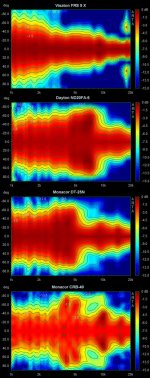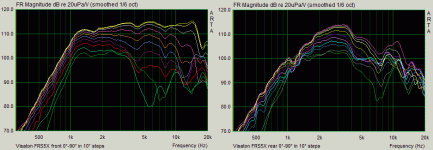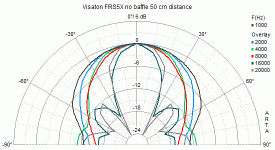I and other have tried using very small back to back tweeters - smaller than the one you've linked to. Unfortunately, the results have been really bad... If you look around the forum some, you'll find a bunch of measurements people have done. The polar response was much poorer than one would have wished for, and was not usable at low enough frequencies - small tweeters just don't have enough displacement. Luckily, the neo3 planar tweeters from B&G are very good. About as good as its going to get without a totally new technology...
I wouldn't say it as harsh as cuibono does, but back-to-back-tweeters have an inherent problem:I and other have tried using very small back to back tweeters - smaller than the one you've linked to. Unfortunately, the results have been really bad... If you look around the forum some, you'll find a bunch of measurements people have done. The polar response was much poorer than one would have wished for, and was not usable at low enough frequencies - small tweeters just don't have enough displacement. Luckily, the neo3 planar tweeters from B&G are very good. About as good as its going to get without a totally new technology...
The lower three drivers are back-to-back tweeters with the Monacor being the largest and the Dayton the smallest package. Note how a "bulging" region moves upward in frequency with diminishing dipole length. The upmost driver is a small cone driver Visaton FRS5X, which does not feature such a bulging region. It is a strong argument for the one-diaphragm-dipole tweeter.
Obviously the Neo 3 is the best dipole tweeter solution available apart from some very expensive AMT tweeters.
Attachments
I add one for the gallery.
This is a double-pack of Peerless Platinum NE19VTC-04, for DIYers aka NE 200 VC, a 0,75" (measured at 1m).
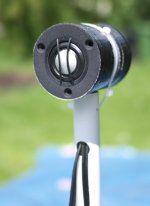
The dipole length is more or less the same as Rudolf's Monachor setup. But the polar response is just...not good. The Klingon Bird of Prey seen from the top with a nice first null at 3.5KHz.
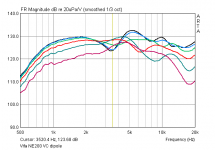
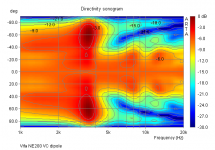
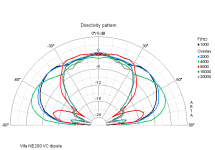
Even if one could have a double-dome-dipole (ddd ) with a nice polar response, it would still be difficult to integrate it into the x-over to the mid driver. Not to mention SPL capability.
) with a nice polar response, it would still be difficult to integrate it into the x-over to the mid driver. Not to mention SPL capability.
I think this is a dead end.

In another recent test I played pink noise while sitting in front of my dipole and slowly turning it. All what really happens while increasing the angle is that the bass fades away (as it should) and then the highs. But it is not that the mids are somehow peaking out all the time. Sure, there still is a spectral imbalance and room for improvement but I think as long as the radiation under angle does not or not significantly (>3dB ?) exceed the 0° SPL you have achieved something. ASW is most likely also impacted by the blooming but that would need a comparison with another speaker being more perfect on paper.
Has anybody ever tested an AMT (2510 without face plate) here ? I would really like to see the response one day. Right now that option is too expensive.
Oh, BTW, the Vifa is mono not bad at all for that money (measured in the same jig).
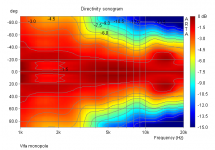
This is a double-pack of Peerless Platinum NE19VTC-04, for DIYers aka NE 200 VC, a 0,75" (measured at 1m).

The dipole length is more or less the same as Rudolf's Monachor setup. But the polar response is just...not good. The Klingon Bird of Prey seen from the top with a nice first null at 3.5KHz.



Even if one could have a double-dome-dipole (ddd
I think this is a dead end.
Agreed. Rudolf do you have the data from the backside of the FRS5x ?The balance of front and rear is more important.
You made up your mind, hu ?I'd choose back to back domes over forward-firing only waveguide.
Also agreed.Seriously though they are not as bad as they look.
In another recent test I played pink noise while sitting in front of my dipole and slowly turning it. All what really happens while increasing the angle is that the bass fades away (as it should) and then the highs. But it is not that the mids are somehow peaking out all the time. Sure, there still is a spectral imbalance and room for improvement but I think as long as the radiation under angle does not or not significantly (>3dB ?) exceed the 0° SPL you have achieved something. ASW is most likely also impacted by the blooming but that would need a comparison with another speaker being more perfect on paper.
Has anybody ever tested an AMT (2510 without face plate) here ? I would really like to see the response one day. Right now that option is too expensive.
Oh, BTW, the Vifa is mono not bad at all for that money (measured in the same jig).

If I equalize the front response to somewhat linear, both look like this:Rudolf do you have the data from the backside of the FRS5x ?
What I still like about the response:
I have tried to keep the colors and the division according to your VIFA diagram. Does the VIFA have some kind of diffusor in front of the dome?
Even if the backside response of the FRS5X rolls off above 4 kHz, the response to the side will stay inside a nice dipole 8 for the front radiation. If I think about it: To me the balance between front and rear is less important than the well reduced radiation to the side.
Attachments
Does the VIFA have some kind of diffusor in front of the dome?
To me it rather looks like children and/or transportation intrusion prevention. I don't think it has serious diffusive character.
You potentially trade depth of the sound stage for potentially harmless ASW effects. You must have some expericence to support this thought. So how's your swinging thingy sounding compared to your other dipole ? You have two to compare. I don't. So what's the difference ? Use some flowery hifi review magazine vocabulary and share the experienceIf I think about it: To me the balance between front and rear is less important than the well reduced radiation to the side.
You made up your mind, hu ?
I think it's the best compromise, and is already a much better topology than any normal speakers out there
Of course we strive for the best and much has/need to been learnt. But they usually also introduce other 'issues'.
- using waveguides: what about the rear radiation? What about H O M
- using different diameter/naked drivers. e.g. Nao Note. Nice. But what about baffle width change. Surely it's not inaudible?
I'm now actually using the dipoles I built 3 years ago. Simple, cheap, and great PRaT, a veil had been lifted. Black notes are blacker and I can hear singers spitting on the microphone .. from my neighbour's kitchen
I've used them in both live (400ms) and dead (250ms) RT60 rooms. Sounded different but equally acceptable.
I went through this thread within last two weeks, it was great to find so many important (though very often neglected) things discussed together in short time.
Special thanks to Raal regarding things to consider choosing mid-drivers, it was very close to my intuitive thoughts/observations, nice to have someone to confirm it. Also to Gainphile on his works on directivity measurements with different waveguides, and Rudolph for starting this thread
So as far "omni vs dipole" can be summarized as that dipole helps fighting early reflections in cases when room treatment isn't justifiable, still being equally usable within treated room. Some suggest that in well treated room monopoles give somewhat better soundstage. Anyway, for home DIY usage I see dipole as somewhat easier choice.
For me questions that are still unanswered in satisfactory detail are:
a) would close to ideal directivity towards HF improve sound compared to typical "decline";
b) positive effects of baffle width/size in dipole configuration for HF (i.e. drivers with waveguides "hanged" vs waveguides suspended in baffle);
c) omni vs figure-8 in 0.3-1kHz range - should we bother about (human-specific perception factor as having difficulty to locate source point in this range) ?
If a) = true, we could work more on waveguide construction, felt usage, ENABL (wasn't mentioned here - too esoteric?), etc.
If b) = true, we could work more on different baffle size/form for HF/MF;
If c) = not true, we could work on finding driver that covers HF down to 1kHz and don't bother with trying to disperse lower midrange. AND we could go for bipole instead of dipole down here.
So how about building a loudspeaker sensitive enough to work with SET amp (93dB/2.83V or more), using minimum of ways (two?), getting away with respectable bass extension (-3dB at 40Hz), having detailed and dynamic sound due close-to-constant directivity above 1kHz and less impact from room due dipole HF and bipole MF/LF setup and.. getting it all done under 500$ per pair? Am I aiming high enough? Anybody have done this already?
Special thanks to Raal regarding things to consider choosing mid-drivers, it was very close to my intuitive thoughts/observations, nice to have someone to confirm it. Also to Gainphile on his works on directivity measurements with different waveguides, and Rudolph for starting this thread
So as far "omni vs dipole" can be summarized as that dipole helps fighting early reflections in cases when room treatment isn't justifiable, still being equally usable within treated room. Some suggest that in well treated room monopoles give somewhat better soundstage. Anyway, for home DIY usage I see dipole as somewhat easier choice.
For me questions that are still unanswered in satisfactory detail are:
a) would close to ideal directivity towards HF improve sound compared to typical "decline";
b) positive effects of baffle width/size in dipole configuration for HF (i.e. drivers with waveguides "hanged" vs waveguides suspended in baffle);
c) omni vs figure-8 in 0.3-1kHz range - should we bother about (human-specific perception factor as having difficulty to locate source point in this range) ?
If a) = true, we could work more on waveguide construction, felt usage, ENABL (wasn't mentioned here - too esoteric?), etc.
If b) = true, we could work more on different baffle size/form for HF/MF;
If c) = not true, we could work on finding driver that covers HF down to 1kHz and don't bother with trying to disperse lower midrange. AND we could go for bipole instead of dipole down here.
So how about building a loudspeaker sensitive enough to work with SET amp (93dB/2.83V or more), using minimum of ways (two?), getting away with respectable bass extension (-3dB at 40Hz), having detailed and dynamic sound due close-to-constant directivity above 1kHz and less impact from room due dipole HF and bipole MF/LF setup and.. getting it all done under 500$ per pair? Am I aiming high enough? Anybody have done this already?
While "directivity" is another category than "decline": Try to keep as much HF in the reverberant field as possible, compared to the direct field. Think "diffusity" instead of "directivity". But I can't tell you, if this will "improve" your sound. I have no idea, what you understand as "improved".a) would close to ideal directivity towards HF improve sound compared to typical "decline";
Aren't "waveguide" and "dipole" contradictive?b) positive effects of baffle width/size in dipole configuration for HF (i.e. drivers with waveguides "hanged" vs waveguides suspended in baffle);
I'm not sure where the problem should be. But if it is part of the stereo illusion or the hearing mechanism, I don't see how omni or dipole would make a difference.c) omni vs figure-8 in 0.3-1kHz range - should we bother about (human-specific perception factor as having difficulty to locate source point in this range) ?
Aren't "waveguide" and "dipole" contradictive?
I need to see the polar pattern of that device. WGs should roll off continuously (for the most part) to the side, dipoles progressively. If it is just two waveguides mounted back-to-back, it would not matter if they are 0° or 180° in phase.
I need to see the polar pattern of that device. WGs should roll off continuously (for the most part) to the side, dipoles progressively. If it is just two waveguides mounted back-to-back, it would not matter if they are 0° or 180° in phase.
Yes, I do need to take some more efforts around measurement to be sure of the exact mode of operation. But the key part is that I have a wide bandwidth (everything over 250) operating as dipole (by the definition that front and rear lobes are 180 degrees out of phase), with significant (and reasonably consistent) directivity in forward and rearward lobes.
I often am behind the speakers in the dining room, kitchen, or at the computer, based on the layout of my living space, and the rear lobes are "aimed" at structural openings into these spaces, so it sounds reasonably balanced in these spaces, and there is a large amount of delay on much of the rear reflections.
I'll take it as a win for now and see if I can get my M-frames to do a clean 250Hz.
AMT directivity
Hi guys,
been reading all this with great interest. I am using some AMT's I bought some time back for about 100€ each as dipole tweeters. They may not be the best available but I love the sound I get. I have never thought about their directivity as I seem to get good dispersion and AMT's, like ribbons are natural dipoles. Has anyone run any tests on the directivity of AMT's. For me they sound very fast and create good soundstage and can be crossed fairly low.
microx
Hi guys,
been reading all this with great interest. I am using some AMT's I bought some time back for about 100€ each as dipole tweeters. They may not be the best available but I love the sound I get. I have never thought about their directivity as I seem to get good dispersion and AMT's, like ribbons are natural dipoles. Has anyone run any tests on the directivity of AMT's. For me they sound very fast and create good soundstage and can be crossed fairly low.
microx
While "directivity" is another category than "decline": Try to keep as much HF in the reverberant field as possible, compared to the direct field. Think "diffusity" instead of "directivity". But I can't tell you, if this will "improve" your sound. I have no idea, what you understand as "improved".
Aren't "waveguide" and "dipole" contradictive?
I'm not sure where the problem should be. But if it is part of the stereo illusion or the hearing mechanism, I don't see how omni or dipole would make a difference.
Rudolf,
By decline I meant typical "considered good" decline of dispersion towards HF (carrot shaped directivity gradient) vs ideal directivity plot (straight lines).
By "improved" I meant typical qualities we expect from sound. Lets leave it as more easy listening over extended periods of time (perhaps years?)
Regarding "waveguide" vs "dipole" - are two opposite waveguide equipped drivers ruining figure 8? I liked idea of experiment placing second WG where compression chamber should be. Still doesn't losing comp chamber means also losing sesitivity? So unless HF driver is more that 6dB more sensitive then the rest I'd go for two HF drivers with waveguides back-to-back with inverted polarity in regards to each other.
I need to see the polar pattern of that device. WGs should roll off continuously (for the most part) to the side, dipoles progressively. If it is just two waveguides mounted back-to-back, it would not matter if they are 0° or 180° in phase.
Linkwitz mentioned somewhat distorted imaging if rear facing HF driver is connected in-phase in regards to front facing.
While on upper HF range polarity could be non-correlated due large front-rear distances (as mentioned by pedroskova #181), then at 1-3kHz it probably is. Even if crossed twice higher than that, HF speakers are still involved in this range, too.
Narrowing dispersion is what happens if you don't take special care. Isn't it mostly marketing which considers this as "good"? I strongly recommend to deliver more HF to the room than that "carrot", if possible. Whether this improved HF is dispersed as a figure-8, omni style or in a bipole fashion is cleary a second rate criterion to me.By decline I meant typical "considered good" decline of dispersion towards HF (carrot shaped directivity gradient) vs ideal directivity plot (straight lines).
Many pop recordings have very exaggerated HF energy in that "carrot". At the moment my dipoles don't fall off very much towards high frequencies. Madonna or Pink for instance have become almost unlistenable. Other recordings show HF details that had been subdued before. So I can't say that such a system supports "easy listening", because it clearly is less forgiving. Certainly I am much more interested in audible excitement than in comfort.By "improved" I meant typical qualities we expect from sound. Lets leave it as more easy listening over extended periods of time (perhaps years?)
A clear and unquestionable YES. Because the acoustic path length difference (dipole separation) to the ears becomes too long for any tweeters. See these illustrations. But it is still a dipole by definition. My goal in this thread has been (and still is) to keep my dipoles in the figure-8 region as high as possible.Regarding "waveguide" vs "dipole" - are two opposite waveguide equipped drivers ruining figure 8?
For sure. And it becomes even worse because the dipole will add low frequency attenuation.I liked idea of experiment placing second WG where compression chamber should be. Still doesn't losing comp chamber means also losing sesitivity?
In that case I would like to know if inverting polarity made any acoustic difference for you.So unless HF driver is more that 6dB more sensitive then the rest I'd go for two HF drivers with waveguides back-to-back with inverted polarity in regards to each other.
This may be true because the Orion tweeters are still working in the figure-8 region at the low end of their passband. Two waveguides back-to-back will never work in the dipole figure-8 region. But this does not mean that it is no worthwhile configuration.Linkwitz mentioned somewhat distorted imaging if rear facing HF driver is connected in-phase in regards to front facing.
Rudolf
The problem with recent recordings is that in order to achieve high RMS (louder = "better") most of them are overcompressed. On the other hand, it somewhat compensates overdamped character of recent mass-production loudspeakers. Our ear sensitivity on mids on dynamically responsive system may indeed receive it as harsh sounding if we have heard better (older) ones. Still I find that on SET amp the effect is less pronounced as there is more "space" for complex musical components that are better separated (a call it "big" sound) and therefore give less work for our brain.
Anyway, just yesterday I finished about two months long crossover tuning by ear combined with ARTA measurements for the following two-way system:
HF dipole (two back-to-back Monacor DT-300 HFs with waveguides), MF + LF bipole (two back-to-back or push-push 12" paper woofers) inside 54cm wide baffle in 40 Hz tuned DTQWT (thanks Troels Gravesen for initial inspiration) crossed at about 1.5 kHz. I started to actually work on it october last year and now when work is almost done (one speaker is built and measured) I can say that I'm quite happy with result.
So
1) I'll try to do subjective test of changing polarity of rear HF drivers from direct to inverted;
2) to take directivity measurements by rotating the speaker and see what type of carrot/flare/whatever it gives for directivity (rear and front) and what kind of "eight" I'll have
We'll be back in a week or so.
Sincerely,
Jānis
Anyway, just yesterday I finished about two months long crossover tuning by ear combined with ARTA measurements for the following two-way system:
HF dipole (two back-to-back Monacor DT-300 HFs with waveguides), MF + LF bipole (two back-to-back or push-push 12" paper woofers) inside 54cm wide baffle in 40 Hz tuned DTQWT (thanks Troels Gravesen for initial inspiration) crossed at about 1.5 kHz. I started to actually work on it october last year and now when work is almost done (one speaker is built and measured) I can say that I'm quite happy with result.
So
1) I'll try to do subjective test of changing polarity of rear HF drivers from direct to inverted;
2) to take directivity measurements by rotating the speaker and see what type of carrot/flare/whatever it gives for directivity (rear and front) and what kind of "eight" I'll have
We'll be back in a week or so.
Sincerely,
Jānis
A clear and unquestionable YES. Because the acoustic path length difference (dipole separation) to the ears becomes too long for any tweeters. See these illustrations. But it is still a dipole by definition. My goal in this thread has been (and still is) to keep my dipoles in the figure-8 region as high as possible.
What is it that you feel is the meaningful distinction between directivity resulting in a figure 8 pattern from your preferred dipole setup and a waveguided one?
Is it just the continuous vs. progressive roll off? You're taking a pretty firm stand on what seems like a pretty minor distinction, within the range where overall energy is low and not terribly consistent. Nothing wrong with wanting this range to be matched as well as possible, but surely there are some significant advantages to be had from dipole tweeter waveguides, particularly in output and low frequency extension, both of which are major limitations with both the neo3s and the dipole daytons (great work btw and impressive results).
And I'd strongly disagree that it doesn't matter whether a bipole or a dipole when waveguided, unless that was applied to the entire system, and I don't see dipolar/bipolar waveguides going to 200hz or below happening anytime soon, so no mattter what you do, assuming you're combining with dipole bass and mids, you need the waveguided midtweeter to be a dipole to maintain a coherent rearwave without cancellation notches. In some systems this would be less significant, such as Stigerik's setup with lots of rear-wall space and absorbtion.
I certainly take your meaning regarding your goals, but just want to make sure we're not discounting well-performing dipoles that don't fit the progressive rolloff model. To my thinking, a full dipole waveguide system is preferable but unattainable due to device size in the midrange, so nude dipoles in combination with the largest possible midtweet waveguide dipoles must be used to get as close as we can. Maybe I'm just addicted to the dynamics of waveguide/horn systems
Last edited:
badman,
from my side this discussion is NOT intended to be about quality of sound, but about quality of understanding. Just for illustration I have merged a (forward) dipole pattern of mine with the radiation pattern of Earl Geddes Abbey (taken from his website) - both at 1 kHz:

I would not dare to draw any conclusions about listening quality differences from the small differences in the patterns. For sure there are larger differences between some different WGs or different dipole constructions than between the red and green line above. Probably both patterns will sound pretty much the same (looking just at the forward direction).
Where I am really finicky about: If people don't care that both patterns are the result of totally different acoustic processes. I know that you care, and my post #196 was not intended to answer Your questions.
I see your point that in a complete "dipole" system the polarities of the front and back waveguides matter a lot. So I totally agree. Sorry that I hadn't that in my view.
But when looking at the front-back waveguide in isolation, I would really like to see where the difference between dipole and bipole can be measured. Only after seeing such measurements I would know, how much (if any) dipole cancellation is really left in the double waveguide.
Last remark: I know and experience my dipoles as real energy annihilation machines. That makes me interested in any double waveguide application that will keep the red line pattern at 60-120°, where it is now - even when adding the mirrored WG. Just waiting for someone to show it ...
That makes me interested in any double waveguide application that will keep the red line pattern at 60-120°, where it is now - even when adding the mirrored WG. Just waiting for someone to show it ...
Rudolf
from my side this discussion is NOT intended to be about quality of sound, but about quality of understanding. Just for illustration I have merged a (forward) dipole pattern of mine with the radiation pattern of Earl Geddes Abbey (taken from his website) - both at 1 kHz:
I would not dare to draw any conclusions about listening quality differences from the small differences in the patterns. For sure there are larger differences between some different WGs or different dipole constructions than between the red and green line above. Probably both patterns will sound pretty much the same (looking just at the forward direction).
Where I am really finicky about: If people don't care that both patterns are the result of totally different acoustic processes. I know that you care, and my post #196 was not intended to answer Your questions.
I see your point that in a complete "dipole" system the polarities of the front and back waveguides matter a lot. So I totally agree. Sorry that I hadn't that in my view.
But when looking at the front-back waveguide in isolation, I would really like to see where the difference between dipole and bipole can be measured. Only after seeing such measurements I would know, how much (if any) dipole cancellation is really left in the double waveguide.
Last remark: I know and experience my dipoles as real energy annihilation machines.
 That makes me interested in any double waveguide application that will keep the red line pattern at 60-120°, where it is now - even when adding the mirrored WG. Just waiting for someone to show it ...
That makes me interested in any double waveguide application that will keep the red line pattern at 60-120°, where it is now - even when adding the mirrored WG. Just waiting for someone to show it ...Rudolf
Rudolf:
All entirely reasonable and fair- and certainly with "pure" dipoles as you're discussing (for lack of a better term) there's a different lobe characteristic and I understand the desire to maintain that, particularly if the discussion is more in the theoretical realm.
At some point I'll get a proper measurement setup together and start posting polars- I've certainly built enough devices with directivity imposed to start working to that effect.
All entirely reasonable and fair- and certainly with "pure" dipoles as you're discussing (for lack of a better term) there's a different lobe characteristic and I understand the desire to maintain that, particularly if the discussion is more in the theoretical realm.
At some point I'll get a proper measurement setup together and start posting polars- I've certainly built enough devices with directivity imposed to start working to that effect.
- Home
- Loudspeakers
- Multi-Way
- On the directivity of dipole tweeters
